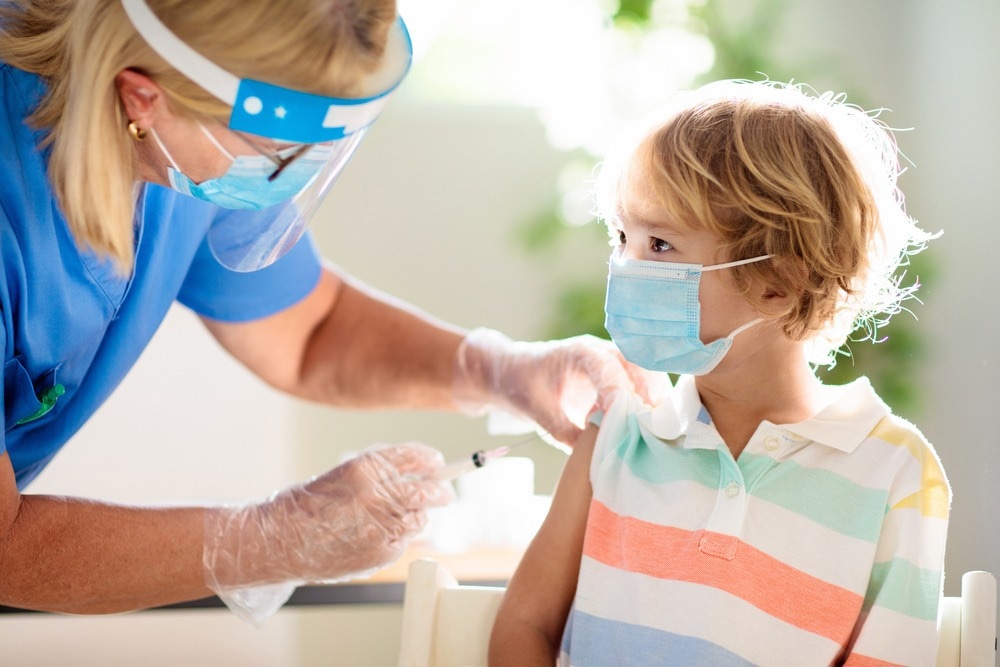In a recent study published in the Morbidity and Mortality Weekly Report by the United States Centers for Disease Control and Prevention (CDC), researchers analyzed the coronavirus disease 2019 (COVID-19) vaccination coverage across demographic factors among infants between the ages of six months and four years in the U.S.

Study: COVID-19 Vaccination Coverage and Demographic Characteristics of Infants and Children Aged 6 Months–4 Years — United States, June 20–December 31, 2022. Image Credit: FamVeld / Shutterstock.com
Background
Early on in the COVID-19 pandemic, adults were believed to be at a higher risk of severe acute respiratory syndrome coronavirus 2 (SARS-CoV-2) infection and hospitalization, especially the elderly and individuals with comorbidities. However, recent statistics have shown that 25% of children diagnosed with COVID-19 require intensive care.
Over three million COVID-19 cases have been reported among children below five years of age. In fact, 21.2% of pediatric COVID-19 cases have progressed to multisystem inflammatory syndrome in children (MIS-C) in children between the ages of one and four. Among infants below one year of age, 3.2% of the cases have been reported to have progressed to MIS-C.
The U.S. Food and Drug Administration (FDA) approved the use of the Moderna and Pfizer-BioNTech messenger ribonucleic acid (mRNA) COVID-19 vaccines for children between the ages of six months and five years and six months and four years, respectively.
About the study
Vaccine administration data in the U.S. is reported to the CDC by federal entities, pharmacies, and jurisdictions using Vaccine Administration Management System (VAMS), immunization information systems (IISs), or direct data submission.
The current study analyzed data reported until February 2023 for children between the ages of six months and four years who had received one or more COVID-19 vaccine doses by December 2022 and were living in one of the 50 U.S. states or the District of Columbia.
COVID-19 vaccine coverage was calculated for the overall pediatric population in the study, as well as by age groups consisting of children between the ages of six to 23 months and two to four years, and by gender and jurisdiction. The U.S. Census Bureau population estimates were used to obtain the demographic data.
Race and ethnicity information was available for 71.4% of the study population. This information was used to analyze vaccine coverage separately for the following races and ethnicities: Hispanic, Black, Asian, White, American Indian or Alaska Native, Native Hawaiian or other Pacific Islander, and others.
Coverage of the first vaccine dose was also calculated according to rural and urban classifications.
Study findings
Vaccine coverage of one or more doses in children between six months and four years of age was 10.1% by December 2022, whereas the coverage of complete primary vaccination series was 5.1%.
The vaccine coverage for one or more doses and complete primary series varied significantly by jurisdiction. The coverage of one or more vaccine doses was in the range of 2.1% in Mississippi to the District of Columbia, where it was 36.1%. Complete primary vaccination coverage was also the lowest in Mississippi at 0.7% and highest in the District of Columbia at 21.4%.
When the vaccine coverages of one or more doses and complete primary series were analyzed by age groups, children between the ages of six and 23 months had coverage of 9.7% and 4.5%, respectively. Comparatively, children in the two to four years age group had coverage of 10.2% and 5.4%, respectively.
Rural counties had a lower vaccine coverage among children between six months and four years of age than urban counties, at rates of 3.4% and 10.5%, respectively. Analysis of vaccine coverage of one or more doses according to race and ethnicity revealed that Hispanic and African American or Black children, who comprise 25.9% and 13.9% of the population, had coverage of 19.9% and 7%, respectively.
Vaccination coverage among six-month-old to four-year-old children was significantly lower than the coverage observed among children of older age groups.
Conclusions
Vaccination coverage among infants and children between six months and four years of age varied according to age, race and ethnicity, jurisdiction, and rural and urban settings. In the five months since the CDC and FDA approved the administration of COVID-19 vaccines to children in this age group, vaccine coverage remains significantly lower than that reported in older age groups of children.
Taken together, the study findings demonstrate the importance of continuing efforts to improve vaccine coverage among children and infants to reduce the risk of SARS-CoV-2-associated morbidity and mortality.
Journal reference:
- Murthy, B. P., Fast, H.E., Zell, E., et al. (2023) COVID-19 Vaccination Coverage and Demographic Characteristics of Infants and Children Aged 6 Months–4 Years — United States, June 20–December 31, 2022. Morbidity and Mortality Weekly Report. 72:183–189. doi:10.15585/mmwr.mm7207a4